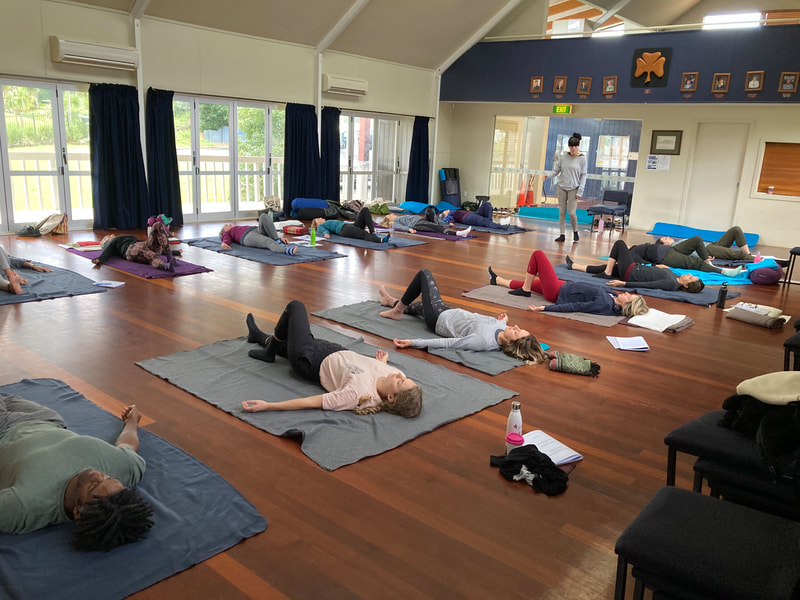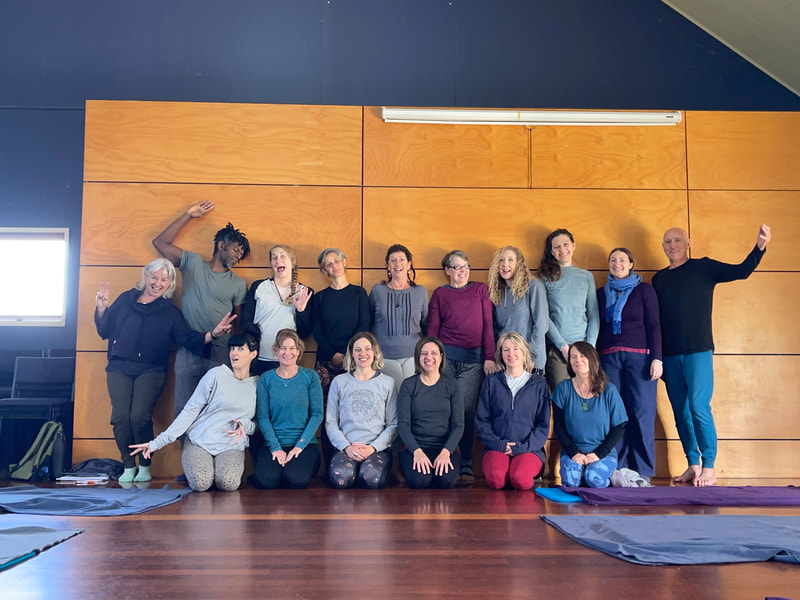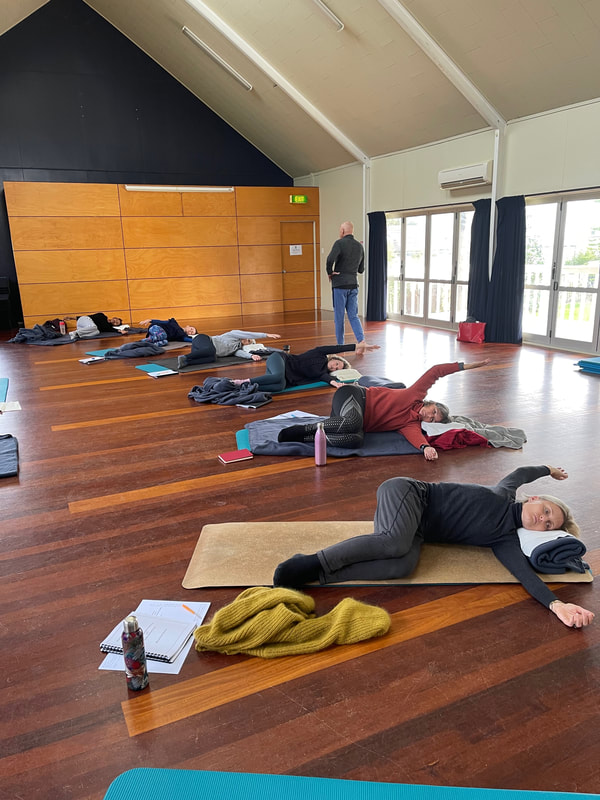75 hours of training over 5 levels
The goal of this training is to have Somatic Movement Education in the tradition of Thomas Hanna accessible for people in New Zealand.
Who is this for?
Level 1: This is the Basics.
- Essential for anyone wanting to develop a very effective, personal movement practice.
- A requirement for anyone wanting to do Levels 2 to 5.
Levels 2 to 5:
- Beneficial for anyone wanting to further develop their personal movement practice.
- Essential for anyone wanting to teach Somatic Movement Education (SME) in the tradition of Thomas Hanna. A commitment to the 5 levels is encouraged.
Each level is of a 3 day duration. The levels need to be completed in sequence.
Friday: 11.00 to 6.00 Saturday: 1.00 to 6.00 Sunday: 10.00 to 4.00
Cost is $400 per level.
Venue is Yoga West Studio in Titirangi Village, Auckland.
Teachers
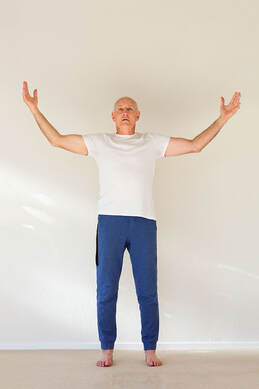
Suds Sutherland
I am qualified in Clinical Somatic Movement Education trained by Martha Peterson of Essential Somatics. I am a qualified teacher, Auckland Secondary College, 1972. I have a Diploma in Physical Education, Otago University 1969 -1971.
I have been teaching weekly classes of SME for 11 years.
I work with clients in a "one on one" clinical situation.
I have been practicing Hanna's movements daily from the moment I was introduced to them 11 years ago. These movements have shown me a new way of "being", a way of being softer, of enjoying everything more, of being more in control of who I am, of slowing down my ageing process and of functioning with more ease and comfort. I have found Hanna’s work so profound that I feel a responsibility to share it with others.
I am qualified in Clinical Somatic Movement Education trained by Martha Peterson of Essential Somatics. I am a qualified teacher, Auckland Secondary College, 1972. I have a Diploma in Physical Education, Otago University 1969 -1971.
I have been teaching weekly classes of SME for 11 years.
I work with clients in a "one on one" clinical situation.
I have been practicing Hanna's movements daily from the moment I was introduced to them 11 years ago. These movements have shown me a new way of "being", a way of being softer, of enjoying everything more, of being more in control of who I am, of slowing down my ageing process and of functioning with more ease and comfort. I have found Hanna’s work so profound that I feel a responsibility to share it with others.
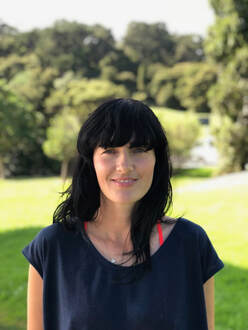
Haidee Stairmand
Haidee is a passionate body explorer and self described anatomy geek. Currently located in West Auckland she teaches yoga and Somatics weekly and works with people individually to improve their body patterns, movements and injuries. She is fascinated by Thomas Hanna's body of work and for the last 7 years she has been practicing the movements daily. Haidee finds this approach to moving and living endlessly inspiring. She brings her own uniqueness to this evolving area while honouring Thomas Hanna's legacy.
Haidee is a passionate body explorer and self described anatomy geek. Currently located in West Auckland she teaches yoga and Somatics weekly and works with people individually to improve their body patterns, movements and injuries. She is fascinated by Thomas Hanna's body of work and for the last 7 years she has been practicing the movements daily. Haidee finds this approach to moving and living endlessly inspiring. She brings her own uniqueness to this evolving area while honouring Thomas Hanna's legacy.
Overview of the trainings
Level 1: The Basics
Introduction to the basic concepts and principles behind Thomas Hanna's Somatic Movement Education. This is a stand alone training for your own personal practice.
These basic movements will provide you with a self-care programme that is so useful for pain, stiffness, immobility, fatigue, stress and general ease of function in every day life.
Learn about sensory motor amnesia. This comes from the many stresses of our daily life and work activities. These stresses, including our emotions, create tight muscles which no longer release fully resulting in postural distortions. These distortions evolve into one or more of three habitual reflexive patterns of holding. You will learn about these three reflexes and their relationship to sensory motor amnesia.
Learn pandiculation, the technique that Thomas Hanna taught to release the tight muscles at a nervous system level.
Learn, explore and practice the basic Somatic movements that are designed to regain your sensory motor awareness.
Level 2:
Revisit the theory, principles and concepts behind SME in the tradition of Thomas Hanna and the movements taught in level 1.
Explore more new movements, some are variations of the basic movements learnt in level 1 and others will connect the periphery to the centre of the body.
Experience a class focusing on movements you have already learnt and relating to the reflexes. Start to understand how to structure a Somatic Movement class.
During this level, you will be given an opportunity to teach a movement(s) to another person, to help develop and refine your own language and teaching skills.
Level 3:
Revisit the movements learnt in Level 2. Learn more new movements.
The focus is to understand and know thoroughly the movements used in Thomas Hanna's approach enabling you to become a competent teacher of them.
Develop further the structuring and teaching of a class.
Level 4:
Revisit the movements learnt in Level 3.
Learn and understand peripheral movements - the lower extremities.
Understand the basics of how to assess a client "one to one". What movements will be most useful for them initially and how you can build on this.
Level 5:
Revisiting movements taught in previous levels and teaching them.
Learn and understand peripheral movements - the upper extremities.
Learn movements appropriate for different issues such as TMJ pain.
Explore alternative ways of practicing movements such as in a chair.
Learn to structure a class with themes such as walking, sporting activities.
Revisit and deepen your understanding of assessment and what movements are most useful for "one to one" clients.
Level 1: The Basics
Introduction to the basic concepts and principles behind Thomas Hanna's Somatic Movement Education. This is a stand alone training for your own personal practice.
These basic movements will provide you with a self-care programme that is so useful for pain, stiffness, immobility, fatigue, stress and general ease of function in every day life.
Learn about sensory motor amnesia. This comes from the many stresses of our daily life and work activities. These stresses, including our emotions, create tight muscles which no longer release fully resulting in postural distortions. These distortions evolve into one or more of three habitual reflexive patterns of holding. You will learn about these three reflexes and their relationship to sensory motor amnesia.
Learn pandiculation, the technique that Thomas Hanna taught to release the tight muscles at a nervous system level.
Learn, explore and practice the basic Somatic movements that are designed to regain your sensory motor awareness.
Level 2:
Revisit the theory, principles and concepts behind SME in the tradition of Thomas Hanna and the movements taught in level 1.
Explore more new movements, some are variations of the basic movements learnt in level 1 and others will connect the periphery to the centre of the body.
Experience a class focusing on movements you have already learnt and relating to the reflexes. Start to understand how to structure a Somatic Movement class.
During this level, you will be given an opportunity to teach a movement(s) to another person, to help develop and refine your own language and teaching skills.
Level 3:
Revisit the movements learnt in Level 2. Learn more new movements.
The focus is to understand and know thoroughly the movements used in Thomas Hanna's approach enabling you to become a competent teacher of them.
Develop further the structuring and teaching of a class.
Level 4:
Revisit the movements learnt in Level 3.
Learn and understand peripheral movements - the lower extremities.
Understand the basics of how to assess a client "one to one". What movements will be most useful for them initially and how you can build on this.
Level 5:
Revisiting movements taught in previous levels and teaching them.
Learn and understand peripheral movements - the upper extremities.
Learn movements appropriate for different issues such as TMJ pain.
Explore alternative ways of practicing movements such as in a chair.
Learn to structure a class with themes such as walking, sporting activities.
Revisit and deepen your understanding of assessment and what movements are most useful for "one to one" clients.
Training dates 2024
Level 1 - 12th, 13th & 14th April. - completed.
Revised dates:
Level 2 - 9th, 10th & 11th August.
Level 3 - 20th, 21st & 22nd September.
Level 4 - 25th, 26th & 27th October.
Level 5 - 29th & 30th November & 1st December.
Level 1 - 12th, 13th & 14th April. - completed.
Revised dates:
Level 2 - 9th, 10th & 11th August.
Level 3 - 20th, 21st & 22nd September.
Level 4 - 25th, 26th & 27th October.
Level 5 - 29th & 30th November & 1st December.
For more information on the trainings or to register your interest contact Suds on
027 227 4161 or [email protected]
To book a place on a training a non-refundable deposit of $50 is required.
027 227 4161 or [email protected]
To book a place on a training a non-refundable deposit of $50 is required.
"If you don't look after your own body where are you going to live?"
